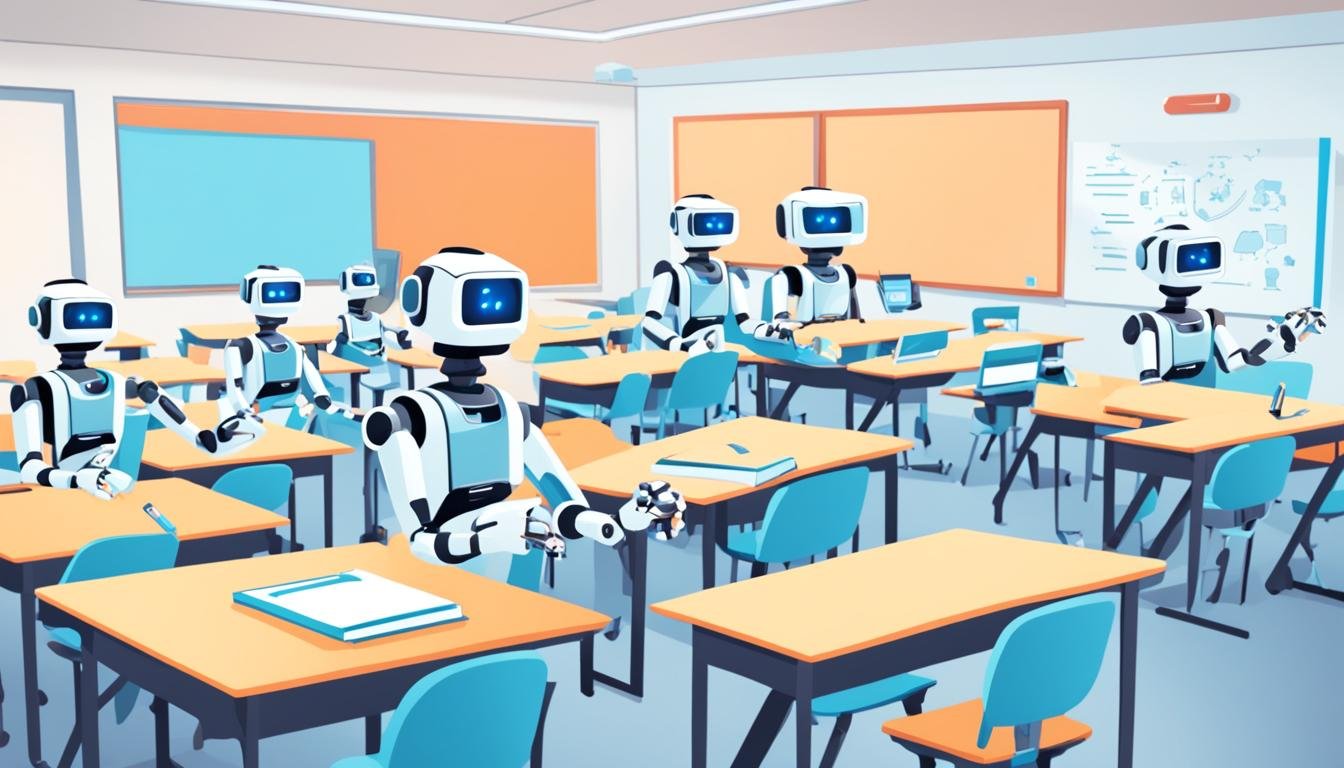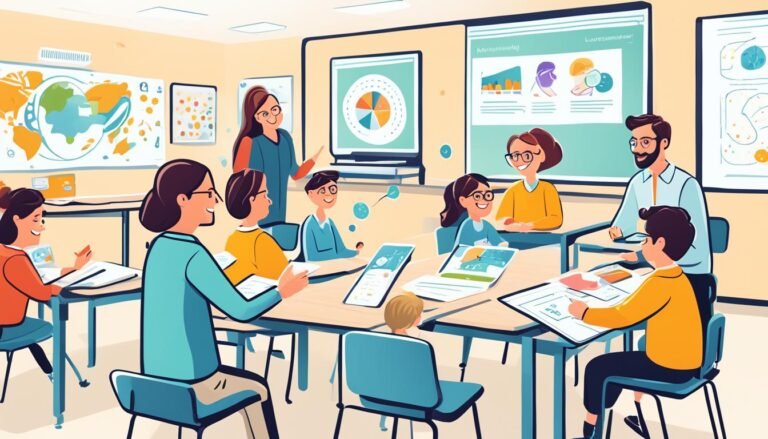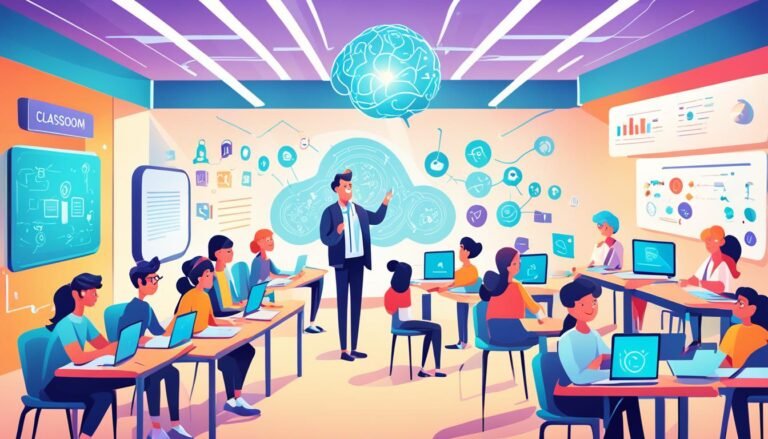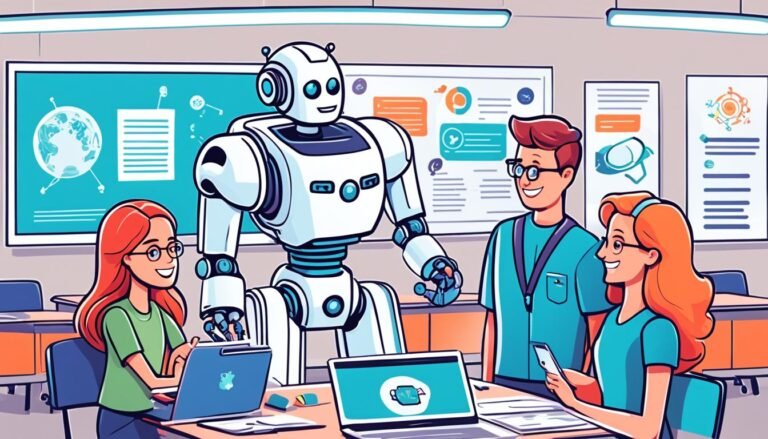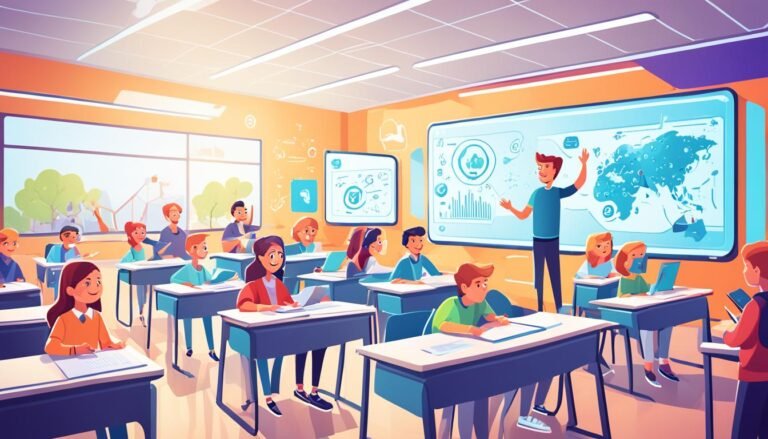AI in Education Examples: Transforming Learning
Imagine it’s 2016, and students at Georgia Institute of Technology are in an online class. They talk to a virtual teaching assistant named Jill Watson and get quick answers. Later, they learn Jill isn’t a person but a virtual assistant powered by AI.
This moment was big, showing the future of education. Now, AI changes how students learn in the U.S. and worldwide. It uses new tech to make learning better for each student.
For example, Thinkster Math uses AI to give each student a personalized tutor. Also, schools use virtual assistants to help teachers with daily tasks. There has been a big jump in using AI for education from 2017 to 2021 in the U.S.
Schools are now teaching about the ethics of AI too. They prepare students for a world where AI is big in education.
Key Takeaways
- AI in education is projected to experience significant growth, revolutionizing learning experiences.
- Technologies like Thinkster Math and Jill Watson illustrate the diverse applications of AI in education.
- AI tools are addressing personalized learning challenges, improving engagement, and alleviating stress.
- AI-driven solutions aid educators by automating administrative tasks and providing real-time insights.
- Adaptive learning with AI promotes inclusion, universal access, and caters to various learning styles.
Introduction to AI in Education
AI is changing the way we learn and teach. It helps meet the unique needs of students better than traditional methods. This makes learning more personal and fun, while also lessening differences in education. The National Science Foundation has led AI research for over 30 years to improve education for everyone.
The Need for AI in Modern Education
Old education systems often couldn’t keep up with student’s needs. This led to lack of personalization and engagement. AI changes this by making learning personal and interactive. Several projects in places like California and Maine are showing how AI can teach AI to students. They are funded by the NSF, starting a new trend.
In 2019, the NSF made guidelines for teaching AI in K-12 schools. They made sure AI had its own place in the school curriculum. They also made cool AI exhibits and games for kids, which kids really liked. This shows AI is making education more interesting for everyone.
Benefits of AI Integration
AI has many benefits for education. It can adjust learning to match each student’s pace and style. This helps make sure all students can learn well. For example, in Maine, an AI bird feeder project shows how AI can teach about nature by identifying birds.
AI also helps teachers by taking care of some administrative work for them. It gives them more time to focus on teaching. For instance, AI can tell teachers how students learn best. This helps teachers teach in the most effective way. Other AI tools, like speech recognition and GPT models, help students learn better and are more fun.
In conclusion, AI’s role in education is a big step forward. By using machine learning and personalized tools, AI is changing how we learn and teach. NSF-funded projects show AI makes education better, fairer, and more fun for students.
AI-Powered Personalized Learning
AI-driven learning is changing the way students learn for the better. It offers custom, effective learning that fits each student’s needs. AI algorithms suggest educational tools that match a student’s skills, interests, and the way they learn best.
AI Adaptive Learning Systems
Adaptive learning platforms powered by AI use student data to create unique learning paths. They change lesson content and speed based on how students are doing. This ensures that every student gets help to succeed. These systems are changing the game in personalized education by always finding new ways to teach.
- Analyzes and responds to student performance data.
- Provides individualized learning paths based on goals and interests.
- Incorporates various formats for multimodal learning experiences.
Benefits of Personalized Learning
AI-driven learning comes with big, wide-reaching benefits. It helps address a lack of teachers by offering personalized help. This lets human teachers focus on creating inspiring spaces for students.
It makes learning more engaging and keeps students’ interest by customizing resources and feedback.
- Closes skills gaps and supports proactive learning.
- Automates assessments and provides personalized feedback.
- Improves educational outcomes through tailored resource recommendations.
Adopting AI in education shows we’re moving from old ways to new, more personal methods backed by data. Learning experts see the big potential in AI, and almost half of students and teachers know its value. AI also brings smart, virtual helpers for learning, which makes studying more interactive and engaging for students.
AI-Powered Tutoring Systems
AI-powered tutoring systems are changing how we learn, tailoring lessons to what each student needs. With powerful AI, students get help in the moment. This makes reaching their goals easier and more personal.
Intelligent Tutoring Systems (ITS)
ITS offer learning that fits each student, helping with tough topics and building confidence. They give exercises that adapt and feedback right away. This lets students go at their own speed, getting a better handle on what they learn.
ITS can:
- Personalize lessons
- Give quick feedback
- Change based on how you’re doing
This flexibility changes lessons depending on how well a student does. For instance, Knewton uses tech to make online lessons just right for every student. They even understand and talk with students naturally, making learning feel more like a chat.
| Key Features of ITS | Benefits |
|---|---|
| Personalized Instruction | Caters to individual learning styles and skills |
| Immediate Feedback | Helps students identify and correct mistakes promptly |
| Adaptivity | Allows students to progress at their own pace |
| Data Analytics | Tracks student performance and progress |
| Scalability | Provides flexible learning options even in under-resourced areas |
By using these high-tech tools, ITS make learning personal for anyone. They help include more people in education, no matter where they are.
Virtual Tutors
Virtual tutors make AI-learning help available all the time. They use AI and NLP to talk and teach like a real person. This makes learning fun and helps keep students interested.
Virtual tutors are great because:
- They’re ready to help 24/7, outside regular classes.
- Lessons fit what each student needs.
- They give useful info to teachers.
Virtual tutors break down walls so that every student can succeed in school. Their constant help and personalized lessons show how powerful AI learning tools are today.
Natural Language Processing in Classrooms
In today’s world, natural language processing (NLP) is key in changing how we learn. It helps make education more fun and interactive for students. This boosts their learning journey.
Role of NLP in Education
NLP enhances students’ reading and writing skills. Apps like Grammarly give tips on writing better. This helps students up their writing game. It also aids teachers in understanding how students learn, allowing them to give personalized help.
NLP also checks student writing and tells them where they need improvement. It quickly spots reading challenges and gives tips in real-time. This makes it easier for students to get better at reading and writing.
Examples of NLP Applications
There are many examples of NLP in education. The NLP-TIPS project is one. It’s being used in six schools in the San Francisco area. This project helps students write better by analyzing their answers and giving them strategies to improve, like adding more details or new ideas.
NLP also grades how well students read, doing better than traditional tests. This tech finds the best reading materials for students. This makes reading more enjoyable and improves how kids learn.
Moreover, NLP understands how teachers and students feel during class. This leads to a better learning atmosphere. Teachers use NLP to see how well students focus. Then, they adjust their teaching to help students more. This makes the classroom a happier and more effective place to learn.
Using NLP in education makes learning better. It shows how powerful technology can be in teaching and learning.
Intelligent Virtual Assistants for Learning
Intelligent virtual assistants are changing how we learn, giving us help all the time. They use AI to do many jobs and make learning better for everyone.
Features and Capabilities
These assistants have lots of cool features to help us learn better:
- They answer our questions right away, so we’re never stuck
- They give us access to different learning materials that suit our needs
- They’re there to help 24/7, keeping us from losing interest and dropping out
The virtual assistant at Georgia Tech, named Jill Watson, answered 97% of student questions correctly. This shows how helpful these tools can be. The chatbot at Georgia State, Pounce, gave over 200,000 answers, which cut down student dropouts by 22%.
Impact on Student Engagement
These assistants make a big difference in how much we stay interested in learning:
- They give us feedback that’s just for us and it helps us learn more
- They find when people copy, so we learn to be honest
- They do lots of boring tasks for us, so our teachers have more time for fun, useful stuff
- The AI assistant from IBM and Rensselaer helps us learn Chinese and other tough topics in fun ways
Thanks to AI applications in e-learning platforms, learning is getting better all the time. Virtual assistants do more than just make things easier. They change learning to fit everyone’s needs better, thanks to AI-enabled educational analytics. This new way of teaching aims to make learning easy to get, personal, and effective for all.
AI in Educational Analytics
AI is changing how we look at education through analytics. It helps teachers make smarter choices that better student learning. In special education, AI tools give teachers a closer look at each student’s progress and needs.
Benefits of AI-Driven Data Insights
AI insights are big wins for teachers. Without AI, sorting through all the data from LMSs like Moodle and Blackboard could be a nightmare. AI finds the important stuff fast, showing educators what they need to focus on.
Natural language processing and machine learning are part of AI’s bag of tricks. They can guess how well a student might do and spot those who might need extra help. Tools like Moodle Analytics and Dropout Detective forecast student success and find which students could be struggling.
Real-time Feedback and Assessments
It’s crucial to always track a student’s progress. AI does this job well by offering instant feedback and assessments. This means teachers can quickly meet each student’s specific needs. Tools like adaptive assessments make sure each student faces just the right challenge.
At Ivy Tech, AI helped save 3,000 students from failing by pinpointing at-risk students. Chatbots, like Jill Watson from Georgia Institute of Technology, are also making a big difference. They answer student questions accurately and quickly, giving students the support they need.
While AI has tons of perks, challenges like transparency and data safety remain. Helping+infoEducators need to think about how they use AI ethically. This includes following privacy laws and making sure AI doesn’t unfairly profile students.
AI and Augmented Reality for Immersive Learning
AI and augmented reality can change education as we know it. They make learning more engaging and help students remember more. AR brings something new to learning, turning boring topics into fun adventures.
Enhancing Learning Experiences
One great thing about AI and AR is how they make learning fun and personal. AI looks at how you learn best and changes the material for you. Studies show that most students learn better with AR or VR. This proves how useful these tools are.
Research says learning online can be much better with AI, up by 80%. AR and VR create virtual worlds for learning. This means lessons can fit any style and speed. No matter how you learn, there’s a way for you.
Examples of AR-Enabled AI Solutions
There are programs that change how they teach based on your skills. Google Expeditions let you visit places like ancient ruins or space. Learning becomes an exciting journey with these tools.
In medical training, AR can customize practice and give instant advice. It can even translate lessons into sign language for students who are deaf. This makes learning more real and open for everyone.
The future of learning mixes AR and AI for everyone’s benefit. It gives teachers a way to help each student better. By 2030, many think the AI market will hit over $2 trillion. AR and VR could reach almost $600 billion. This shows how important and fast these changes are happening in education.
| Statistic | Insight |
|---|---|
| Projected AR and VR market by 2030 | $597.54 billion |
| Projected AI market by 2030 | $2025.12 billion |
| Retention rate when taught using AR or VR | 75% |
| Engagement increase in eLearning with AI | 80% |
| Businesses planning to invest in AR and VR by 2025 | 90% |
AI-Enabled Tools for Special Education
AI tools are changing the game in special education. They offer custom support for students with different needs. This makes learning more inclusive, accessible, and effective.
Supporting Students with Special Needs
AI can track student data to create personal learning experiences. For example, Formative AI changes the educational content to fit each student. This helps students with special needs do better.
For those with hearing or speech issues, text-to-speech and speech recognition are vital. Tools like Read&Write and AudioPen help out. They read or write out text and understand many languages.
Examples of AI Applications
AI is doing big things in special education:
- Gradescope: Makes grading easier, so teachers can focus more on students.
- Almanack AI: Gives advice based on how students are doing, to make learning better for them.
- QuillBot: Helps with grammar and writing, to boost understanding and skills.
- Scribbr: Checks up on grammar and style in academic work, to make it great.
- Nearpod: Creates fun lessons and checks progress as it goes, to adjust to student needs.
- BrainPOP: Breaks tough topics into easy-to-understand videos, for all students.
These AI tools make education more welcoming and helpful. They ensure every student can do their best. Let’s see how AI changes special education.
| AI Tool | Function | Benefit |
|---|---|---|
| Formative AI | Adaptive learning algorithms | Personalized learning experiences |
| Read&Write | Text-to-speech | Enhanced engagement with content |
| Gradescope | Automated grading | More focused individual instruction |
| AudioPen | Transcription services | Supports multiple languages |
| Almanack AI | Real-time analytics | Dynamic learning adaptations |
| BrainPOP | Animated educational videos | Simple breakdown of complex topics |
AI in E-Learning Platforms
Artificial Intelligence is changing online learning for the better. It boosts accessibility and adds flexibility to digital schooling. AI chatbots and virtual helpers are there 24/7 for students. They make learning much easier. They can turn text into speech and speech into text. This helps students with special needs. It makes sure everyone can learn their own way.
Improving Accessibility and Flexibility
AI makes online learning better in many ways. It looks at how students learn, using AI tools. It helps every student do their best. For example, it finds students who need extra help. This way, everyone gets the support they need. AI also helps find information in lessons quickly. This makes studying more efficient for everyone.
Popular AI-Integrated E-Learning Platforms
Many top e-learning sites now use AI for better learning. Duolingo changes its language lessons based on your skills. Thinkster helps with math, pairing AI with a real teacher for kids in grades K–8. Querium and Alta by Knewton help in STEM subjects. They give quick tips on solving problems and find where you need to improve. These tools show how AI is changing education for the better.
Source Links
- 43 Examples of Artificial Intelligence in Education
- How Is AI Used In Education — Real World Examples Of Today And A Peek Into The Future | Bernard Marr
- AI in Education: Benefits, Use Cases, Challenges, Cost & More
- AI education and AI in education
- AI in Education
- AI in Education: 19 Examples to Know | Built In
- How AI Is Personalizing Education For Every Student
- How to Create Personalized Learning Experiences Using AI
- AI In Education: Examples to Apply Your Knowledge | Frog Street
- AI Tutors: How Artificial Intelligence Is Shaping Educational Support
- Use Case 2:10 Revolutionizing Education with AI Intelligent Tutoring Systems (ITS)
- Intelligent Tutoring Systems: Enhancing Learning through AI
- NLP and Its Use in Education – InData Labs
- Designing Natural Language Processing Tools for Teachers
- Deepening Science Teaching and Learning with Language AI
- From virtual assistants to intelligent tutors: How AI is changing higher education
- The future of education: teachers and virtual AI assistants hand in hand?
- Successful AI Examples in Higher Education That Can Inspire Our Future
- AI-Driven Evolution in Learning Analytics for Digital Education
- Generative AI in Education: Examples, Benefits, Challenges
- Artificial Intelligence In Education: Teachers’ Opinions On AI In The Classroom
- The Future Of eLearning: How AR, VR, And AI Are Changing The Game
- Immersive Learning: The convergence of AR, VR, and AI in education.
- Augmented Reality and AI in Education
- 24 Best AI Tools for Special Education Teachers in 2024 – MTI: Professional Development Courses & Graduate CE for Teachers
- AI in Special Education
- 7 AI Tools That Help Teachers Work More Efficiently
- Harnessing The Power Of AI In eLearning: Revolutionizing Education
- 6 AI Use Cases That Can Transform Your eLearning Platform
- 4 Examples of AI Being Used in E-Learning | LearnDash

